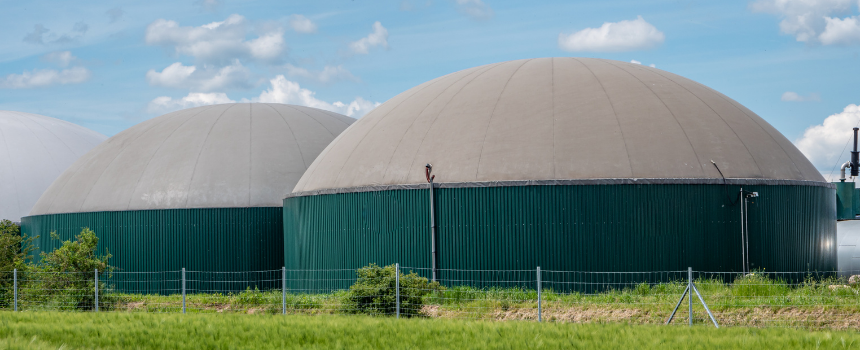Biogas is a type of biofuel produced during the bacterial breakdown of organic matter, such as livestock manure, agricultural and industrial waste, inedible food waste, and wastewater. Although the breakdown can occur naturally, biogas is produced ideally in a controlled environment, called a digester. This digester maintains an optimal temperature and an oxygen-free environment for the bacteria to consume the “feedstock,” or waste. This is known as “anaerobic digestion.” This anaerobic digestion process produces methane (CH4), along with carbon dioxide (CO2) and smaller amounts of water vapor, particulates, and other gases, such as H2S. Methane is captured and is available for use as a fuel for any direct combustion system, such as turbines, heaters, cooking stoves, and fuel cells and is often recirculated into the existing biogas recovery system as a fuel.
The anaerobic digester can significantly vary in size depending on the application, ranging from consumer backyard recycling to massive industrial processing plants. To produce biogas, the system must maintain optimal operating conditions: no oxygen, warm temperature, and neutral acidity.
WHAT ARE THE KEY BENEFITS OF BIOGAS?
- Renewable energy source – Biogas is a renewable energy source, which means that the raw materials (such as crops and livestock waste) used in biogas production are quickly replenished, making more raw materials available. Compare that to fossil fuels, such as oil, coal, and natural gas, which take millions of years to produce.
- Reduction of greenhouse gases – The production of biogas utilizes feedstock that would otherwise release methane into the atmosphere. Although the combustion of biogas produces carbon dioxide (similar to the combustion of natural gas), the capture and reuse of methane is a significant climate benefit since methane retains much more atmospheric heat radiation compared to CO2. Pound for pound, the comparative impact of methane is 25 times greater than CO2 over a 100-year period (EPA).
- Fertilizer from biogas production – While methane capture is the main focus of biogas production, the material remaining, called “digestate,” is rich in nitrogen, potassium, phosphorus, with both liquid and solid byproducts. This digestate is usable as soil conditioner and organic fertilizer, and it can reduce the need for synthetic fertilizers that can be costly and detrimental to the environment. Compared to manure, the digestate can also have a much lower pathogen load and significantly lower odor.
- Additional revenue streams and cost avoidance – Although there are startup costs associated with biogas collection, there are ongoing revenue streams available to offset these costs. For example, a farm or biogas processing plant can receive “tipping fees” for gathering or accepting feedstock from other local sources. The digestate can be processed and resold as liquid and solid organic fertilizer. Of course, there is revenue from the sale of excess biogas. Many local, state, and federal entities offer investment tax credits or production tax credits as incentives. Similarly, carbon offset credits can be earned and sold/traded as commodities.
OKAY, IS THERE A DOWNSIDE TO BIOGAS?
Although there are many benefits to biogas, there are also some challenges in achieving success in this area. Here are some of the current challenges:
- Refinement needed – The “raw” biogas produced in an anaerobic digester contains methane, carbon dioxide, hydrogen sulfide, and other impurities. These impurities must be removed or at least reduced through additional chemical processes to separate the methane. Running sensitive systems like internal combustion engines (such as the ones in biogas powered busses) with these impurities can corrode the metal surfaces and increase maintenance costs. The digestate must also be processed to be utilized in liquid and solid forms. H2S removal from a gas stream in landfill gas applications can be achieved with FerroSorp® H2S removal media. FerroSorp removes H2S with high efficiency, saving your company time and money.
- Sustainable business model – The biogas production environment needs a reliable supply chain. It starts with a consistent feedstock supply, an anaerobic digester of appropriate capacity, knowledgeable workers and management, and clients to buy the excess biogas and fertilizer products. Adherence to local, state, and federal government compliance standards and guidelines is also essential, especially if tax credits or offsets are being claimed.
- Large–scale production difficulty – With today’s technology, it is not feasible to expect that biogas production would replace existing energy production in oil/gas, wind, and solar. In 2019, biomass (renewable organic material from plants and animals) provided approximately 5% of the US’s total primary energy use (EIA). However, in rural areas where feedstock is plentiful, smaller-scale production can be successful with a sustainable business model.



